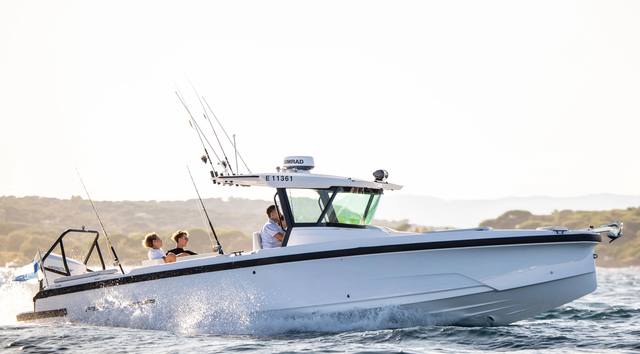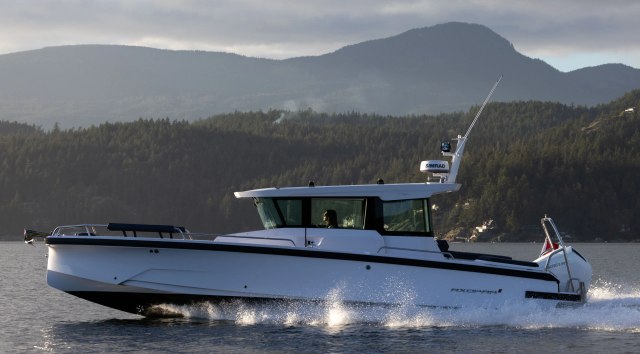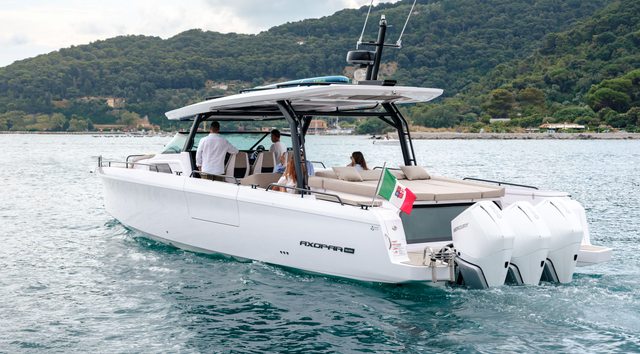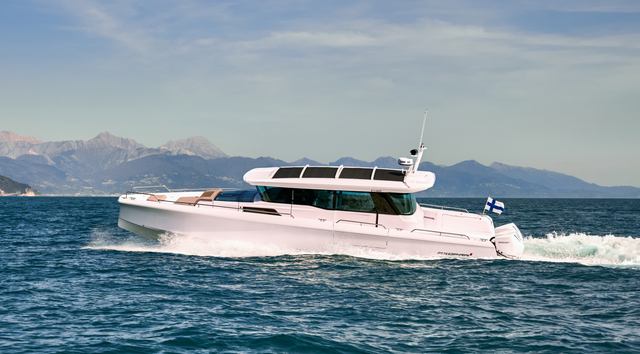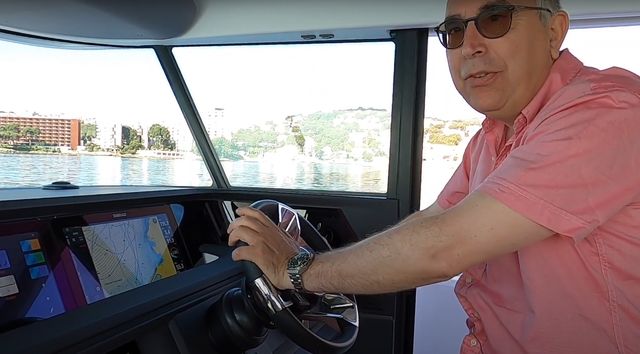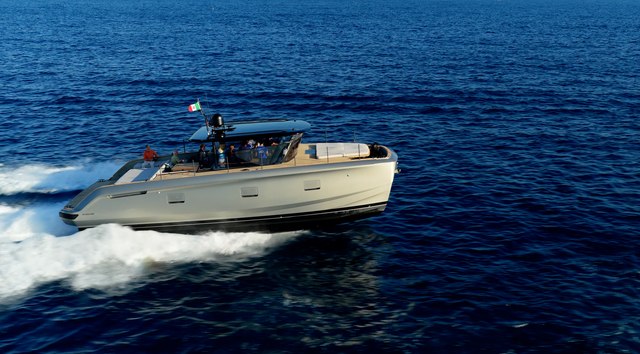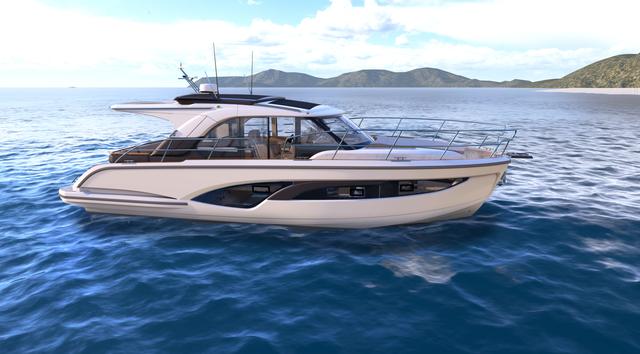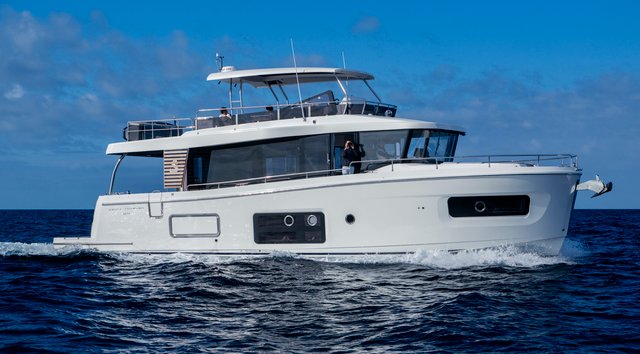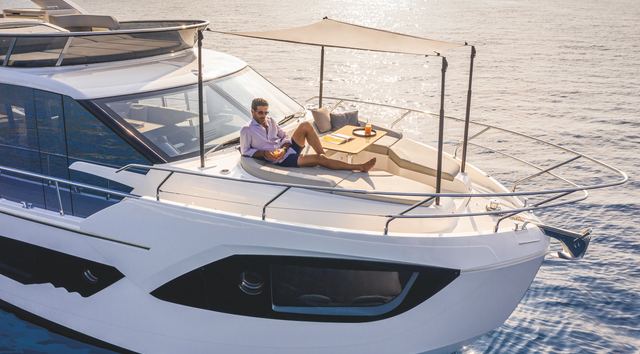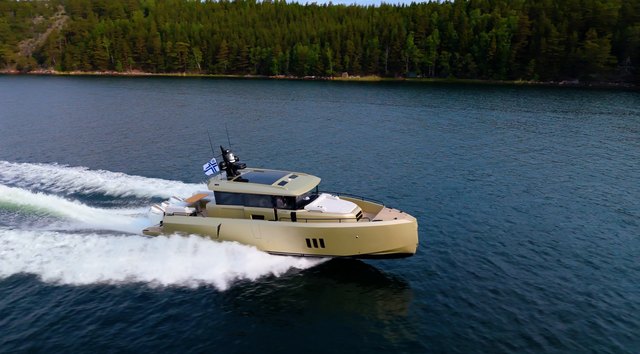You know the question that hangs over every electric boat: can it really deliver the same thrill as a petrol hull? With Axopar the answer matters even more, because performance is the brand’s calling card.
So when they pulled the outboard off a 25 and bolted on a 225-kilowatt electric motor and a 126kwH battery bank, the challenge was clear - could this still feel like an Axopar? Especially when the AX/E 25 Cross Bow carries a price tag of around €229,000, well over double what you’d typically pay for a petrol-powered 25.
Axopar AX/E 25 Cross Bow Key Facts

- LOA 26' 3"
- Model Year 2023
- Cabins 1
- Status In Production
- Yacht Type Sportscruiser
- Use Type Cruising
Test & Review Video
Ease the throttle forward and the first thing you notice is what you don’t hear. At six knots the boat just ghosts along with a soft hum from the motor, the rush of water past the hull, and little else. The displays give you the numbers in real time: around five hours of running and 26 miles at this speed. It’s not a pace you’d choose offshore, but as a way of drifting across a lake or sneaking down a river it’s remarkably calm, and oddly addictive.
Feed in more power and the character changes, though not in the way a petrol boat does. There’s no roar or smoke, just a deeper note and a shove of torque that picks the hull up cleanly onto the plane. At a steady 21 knots we were seeing half an hour of range, not very far but enough for the inland waters this boat is aimed at. Stop for lunch, plug in, and you’re topped up again before the afternoon run.

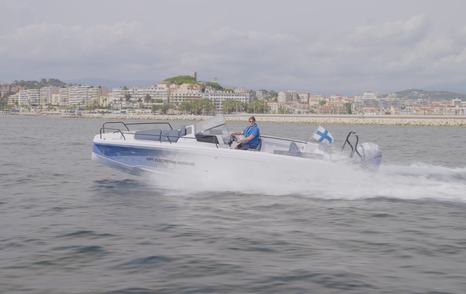
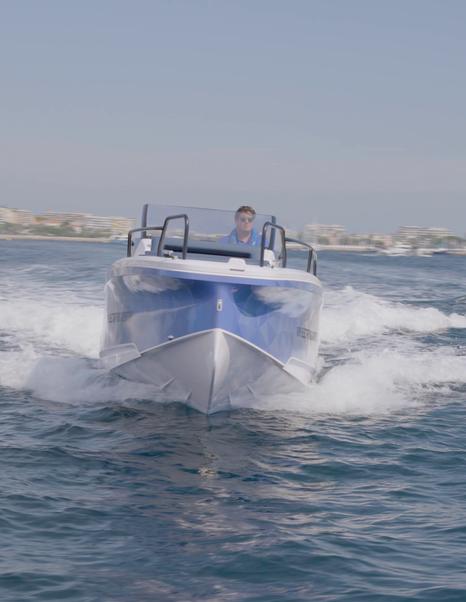
The real surprise comes when you open the taps. Lift the trim, lean on the throttle, and the AX/E 25 takes off - we saw 47 knots, and Axopar has had 52 on test. Even our chase boat with twin 200s couldn’t keep up. Acceleration is instant, bow rise is minimal, and the boat feels alive.
And through it all, the hull feels exactly like the petrol 25. Same twin steps, same narrow entry, same soft ride. In the chop around Cannes, where the traffic never lets up, the AX/E sliced through without fuss. The extra weight of the batteries sits low in the hull, so instead of blunting performance it adds a sense of solidity - the boat feels planted and predictable, yet still nimble in a hard turn.
So you end up with a familiar Axopar driving experience, only quieter and more responsive.
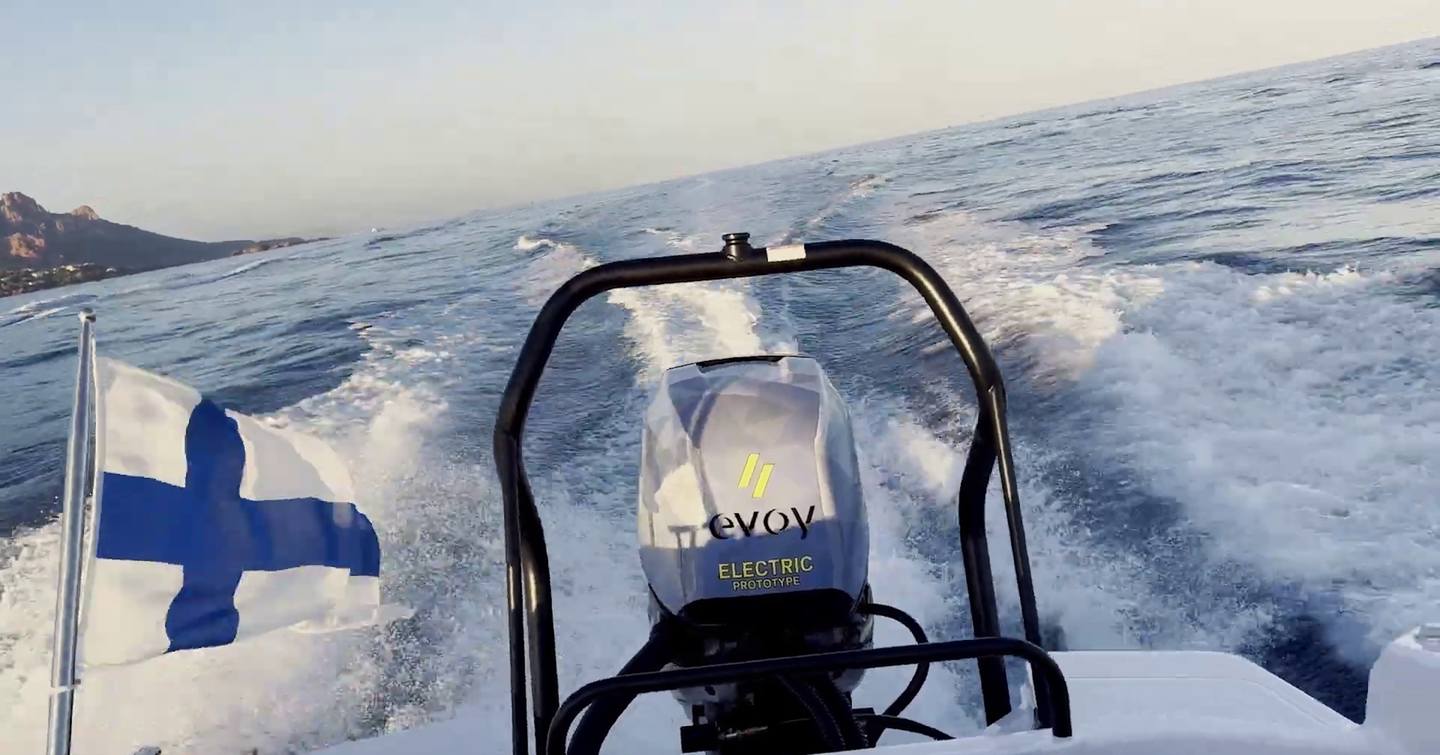
This is still the sharp, twin-stepped 25-foot hull from Jarkko Jämsén’s studio, just with a different heartbeat. The lines, the narrow beam, the familiar walkaround decks – it’s all recognisably Axopar. Which is the point. You step on board and it feels like a 25 you already know, only this one is running on electrons rather than petrol.
The clever bit lies in the integration. Under the aft deck sits the 126 kWh battery bank and the management systems that make the whole thing tick. Rather than robbing you of lockers or social space, Axopar’s multi-storage module has been adapted to swallow the charging gear neatly, so day-to-day it just feels like another smart bit of deck furniture. Lift a hatch and you’ll find the brains, properly get-at-able if you ever need to swap a service battery or plug in.
The build itself has had subtle tweaks to suit its new role. There’s more weight on board than the petrol 25, but it’s concentrated low in the hull, acting like ballast. That extra mass helps the boat sit solidly in the water – it feels planted rather than compromised. From a construction point of view, Axopar hasn’t cut corners: the hull is the same hand-laid GRP, the finish is still crisp, but the detailing gets a lift. Teak highlights on the helm, AX/E-branded upholstery, even olive green hull lettering to mark it out as something different.
What’s telling is how little has changed above deck. You still have the same choice of Cross Top or Cross Bow layouts, the same cuddy cabin under the foredeck, the same modular aft cockpit furniture. That continuity is deliberate. It means Axopar has built a 25 that just happens to be electric. And that’s a reassuring starting point for anyone wondering how far a first-generation e-boat might stray from the tried and tested formula.

Range and Charging
At displacement pace the numbers look generous – five hours of running and 26 miles on the clock – but ease up to a 20-knot canter and reality sets in. Half an hour of range at that speed doesn’t sound like much, and offshore it really isn’t. This boat’s brief is different. It’s aimed squarely at the lakes and inland waters of northern Europe, where legislation is already pushing owners toward electric. In that setting, dotting about at modest speeds, the figures make sense.
The displays tell the story as you go. Speed, consumption, range in miles and range in minutes, all updating live with every squeeze of the throttle. It’s neat, clear, and gives you confidence in how much time you’ve got left on the water.
Charging, too, is designed to be simple. Plug into a DC fast charger and you can go from low to 80% in under an hour. Even on a standard shore power socket you can top up while you’re stopped for lunch. That’s the rhythm this boat suits - short hops, quick breaks, another run. For tender work or day boating on inland waters, that kind of pattern fits neatly.
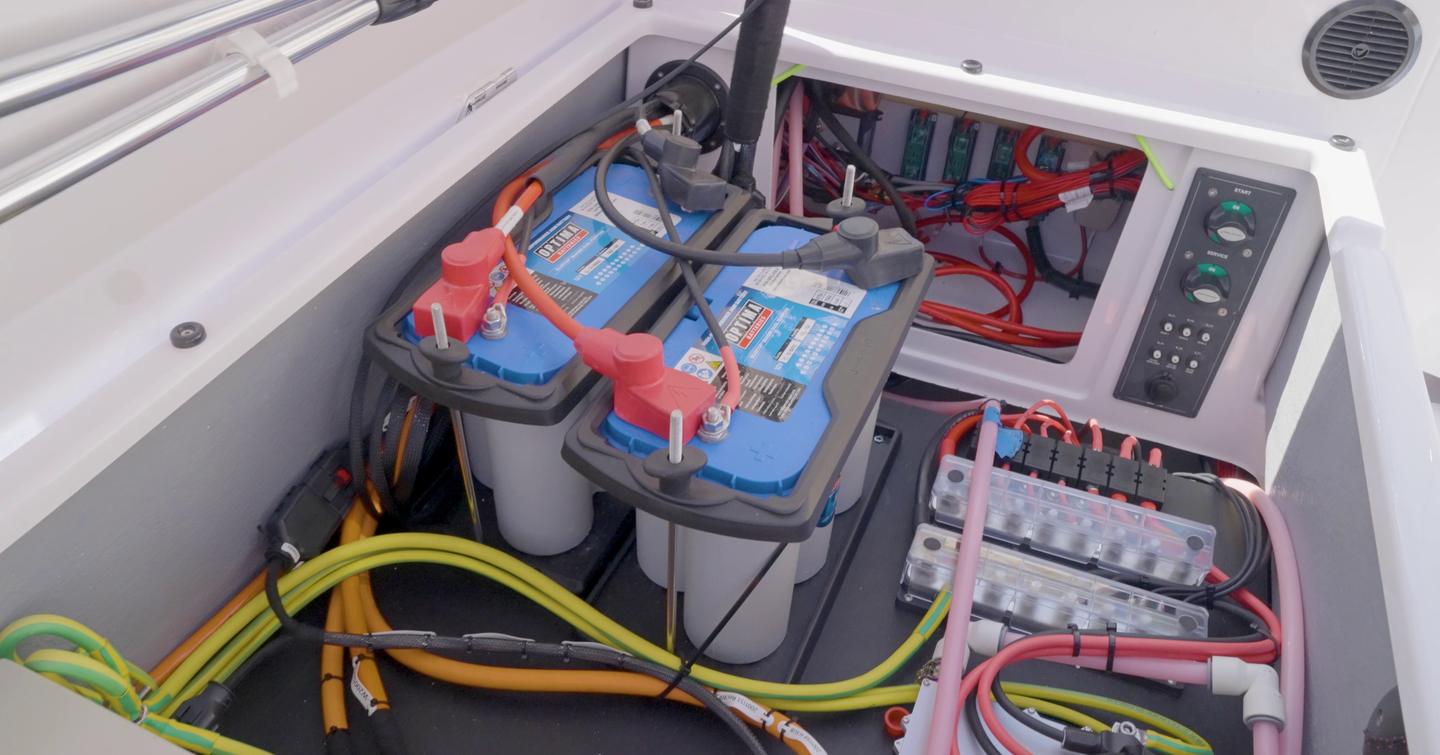
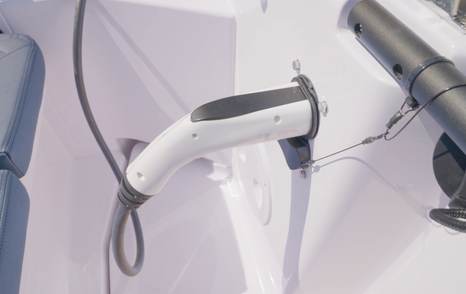
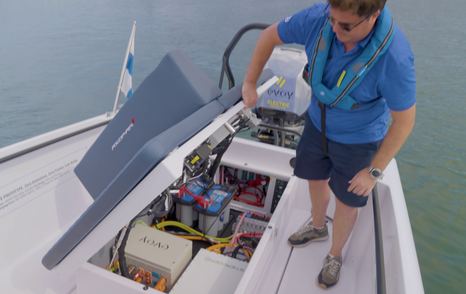
Through a sliding hatch on the starboard side, you find the cuddy cabin tucked neatly beneath the foredeck. It's a simple V-berth that will take two adults, with decent length and just a handy space to have on such a 25ft boat. A skylight overhead brings in daylight and air, and there are canvas wall pockets and a small bench to make it feel less like a crawl space and more like a place you could actually spend the night.
It’s more of a practical bolt-hole if you want to extend a day into a weekend. Owners can add an electric toilet package and a freshwater sink, which lifts the cabin into usable overnight territory. With those fitted, it’s enough for a couple to manage a night away without compromise, and still leave the main deck clear for socialising.
The upholstery is done in the same AX/E style as the cockpit - a cut above what you might expect at this size. There’s carpeting underfoot, soft lighting, and the whole space feels thought through rather than an afterthought. What matters is that nothing was lost in translation when the boat went electric - the cabin is the same as you’d get in the petrol 25, right down to the headroom.

The driving position gets its own spotlight because it’s where the AX/E has rewritten the script. The fundamentals are the same: two adjustable seats with flip-up bolsters, a leather-wrapped wheel, decent footrests, and good all-round visibility through that wraparound windscreen. Slide in and it feels no different to a petrol 25.
The difference lies in the dash. Instead of a single chartplotter and a tacho, you now have a clean panel with teak trim and twin digital displays - one for navigation, one feeding you live electric data. Speed, consumption, state of charge, even predicted range in miles and minutes update in real time, so you always know what’s left in the tank, so to speak. The switchgear is still reassuringly tactile, with backlit push buttons, so it doesn’t feel like you’re at the mercy of touchscreens alone.
It’s a neat blend of the familiar and the futuristic. You grip the same wheel and sit in the same seat as any other Axopar 25 - but the information in front of you belongs to the next generation.
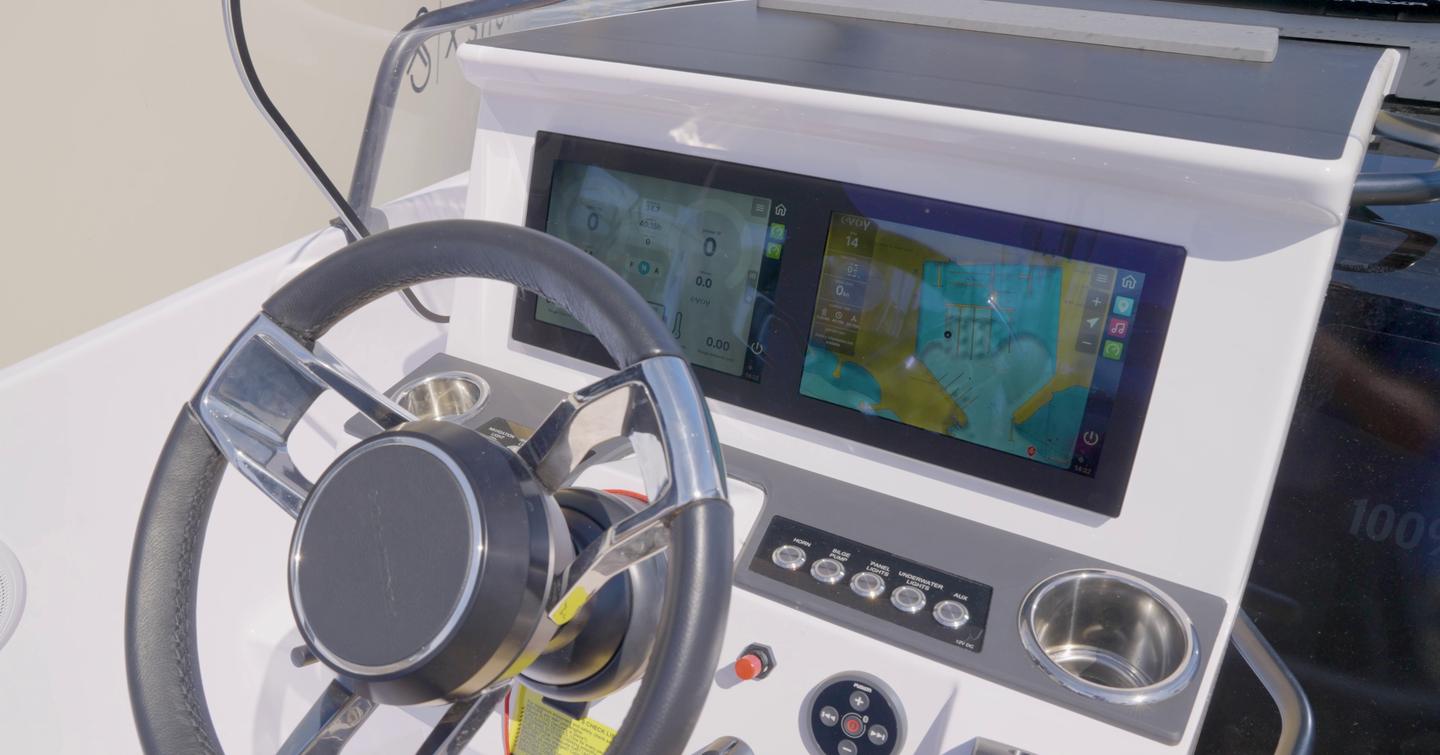
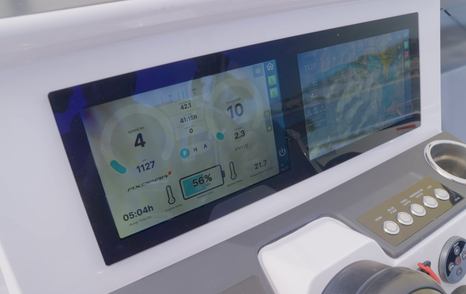

Step aboard at the stern and you’re straight into one of Axopar’s party tricks, which is it's great range of choice. The aft section can be configured with a broad sunpad, a U-shaped sofa with a teak table, or a multi-storage module that doubles as the perfect place to house the charging kit. On the electric version that last option makes a lot of sense, as it hides away the gear without eating into your usable deck space. Either way, you’ve still got a wide swim platform and a sturdy ladder, so dipping in and out of the water is just as easy as on the petrol 25.
From there the deck runs forward with Axopar’s familiar asymmetric walkaround. The port side is broad enough for an easy shuffle to the bow, with rails to hand all the way. The starboard side is narrower, given over to a full-length sunpad that tucks neatly beneath the windscreen. That asymmetric layout is clever in practice – you get a proper lounging space without giving up safe access to the foredeck.

Carry on to the bow and the cuddy cabin sits under here with padded seating on top. And the open bow retains Axopar’s step-through design so it can nose up to a beach or hop off at a quay, with the low rails giving you something to hold onto as you do it.
So the deck plan is reassuringly familiar. The AX/E hasn’t compromised the layout to make way for its batteries and cables. Instead, it’s the same easy-access Axopar deck you’d expect - only now with the option to stash your charging kit where a cool box might otherwise go.
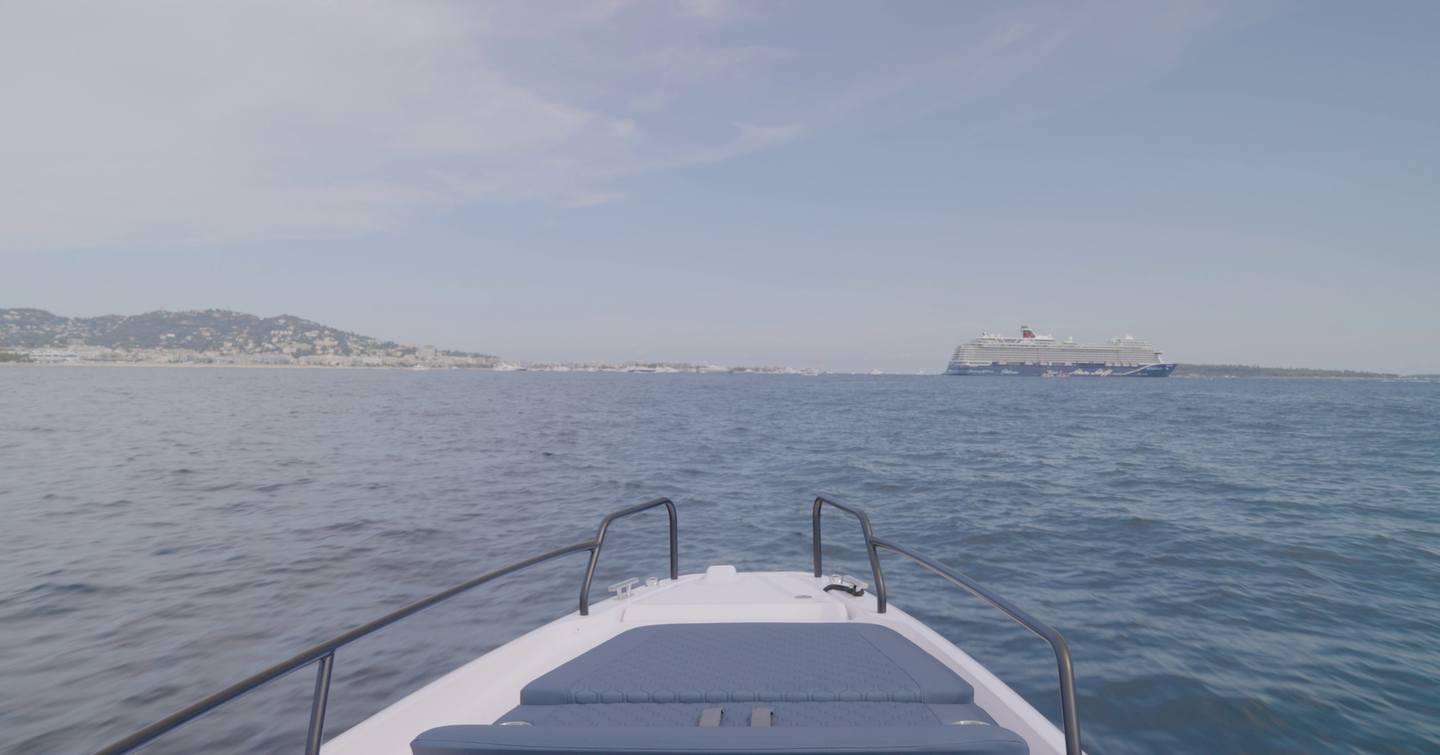
Our Verdict
Out on test the answer to our earlier comes quickly. Does it still feel like an Axopar? Yes, the range is limited, and yes, this early boat still wears its prototype label. But the performance is convincing. It feels just like a 25, only now the power comes with a rush of torque and far less commotion. The data is all live on screen, the charging is straightforward, and for the kind of work this boat is built for it makes a lot of sense.
So the question becomes not can an Axopar be electric, but where it fits best. As a lake boat in northern Europe, as a quiet, fast tender for a larger yacht, or as a day boat for an owner happy to plan around charging stops, the AX/E 25 is already good enough to slot in, but not yet with the long-legged cruising freedom that petrol power still gives you.
Reasons to Buy
- Instant shove, no lag at all
- Quiet running
- Familiar Axopar hull and layout
Things to Consider
- Range shrinks fast at speed
- Not for offshore cruising
- Extra heavy and extra pricey
Specifications
- Builder Axopar
- Range AX/E
- Model AX/E 25 Cross Bow
- Length Overall 26' 3"
- Beam 7' 4"
- Draft 2' 9"
- Hull GRP
- Cabins 1
- Berths 1
- Yacht Type (Primary) Sportscruiser
- Use Type (Primary) Cruising
Interested in a AX/E 25 Cross Bow?
NEW Build
Find your local dealer for a personalised, no-cost consultation
or just request
Brochures & Pricing
Used & In Stock
Looking for a ready-to-go AX/E 25 Cross Bow or pre-owned options? Explore all inventory of the AX/E 25 Cross Bow available worldwide




